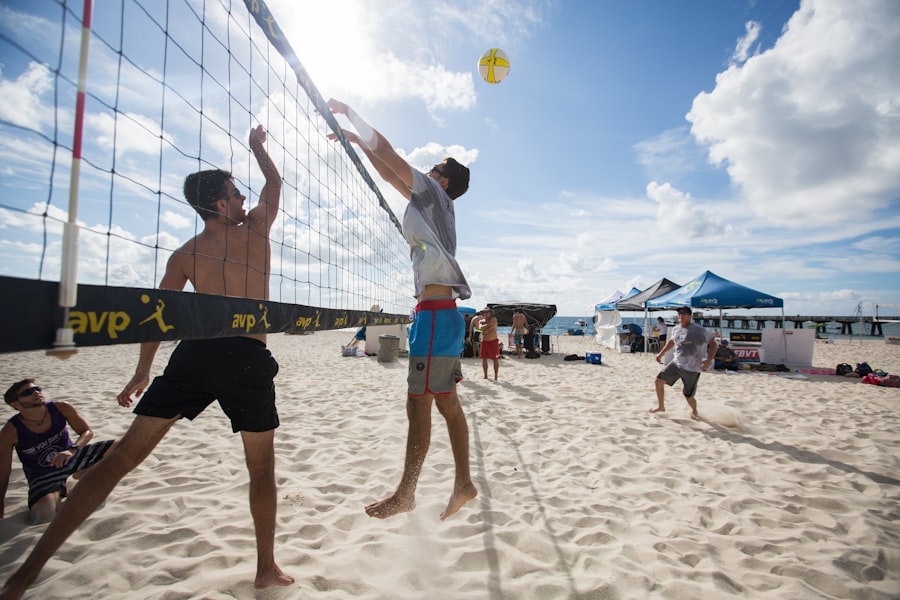Download links
How to install Mastering the Art of Volleyball: Tips for Success APK?
1. Tap the downloaded Mastering the Art of Volleyball: Tips for Success APK file.
2. Touch install.
3. Follow the steps on the screen.
Description
Volleyball is a dynamic and fast-paced sport that has captivated millions around the globe. Originating in the United States in 1895, it has evolved into a highly competitive game played both indoors and on the beach. The fundamental objective of volleyball is straightforward: two teams, typically consisting of six players each, aim to score points by sending a ball over a net and into the opposing team’s court.
The game is played in sets, with teams needing to reach a predetermined number of points, usually 25, to win a set. A match is typically played in a best-of-five format, adding layers of strategy and endurance to the competition. The court dimensions are standardized, measuring 18 meters long and 9 meters wide, divided by a net that stands at 2.43 meters high for men and 2.24 meters for women.
Each team has three front-row players and three back-row players, with specific roles that contribute to both offensive and defensive plays. The rotation system ensures that all players participate in various positions throughout the match, enhancing their versatility and understanding of the game. The rules governing volleyball are designed to promote fair play and sportsmanship, with violations such as net touches or foot faults leading to point deductions for the offending team.
Key Takeaways
- Volleyball is a team sport played with six players on each side, aiming to score points by grounding the ball on the opponent’s court.
- Essential skills for success in volleyball include passing, setting, hitting, blocking, and serving.
- Mastering serving and receiving in volleyball involves understanding different types of serves and developing effective passing techniques.
- Improving defensive and offensive strategies in volleyball requires players to work on positioning, timing, and communication to outmaneuver the opponent.
- Enhancing communication and teamwork in volleyball is crucial for coordinating plays, supporting teammates, and maintaining a positive team dynamic.
- Mental and physical preparation for peak performance in volleyball involves training for agility, strength, endurance, and maintaining a focused and resilient mindset.
Developing Essential Skills for Success
To excel in volleyball, players must cultivate a diverse set of skills that encompass both individual abilities and team dynamics. Fundamental skills include passing, setting, hitting, blocking, and serving. Each skill requires dedicated practice and an understanding of the mechanics involved.
For instance, passing, often referred to as “bumping,” is crucial for receiving serves or attacks from opponents. A well-executed pass allows the setter to deliver an accurate ball to the hitter, setting up an effective offensive play. Players must focus on body positioning, hand placement, and timing to ensure successful passes.
Setting is another critical skill that demands precision and quick decision-making. The setter acts as the playmaker, determining which hitter will receive the ball based on the defense’s alignment and the flow of the game. A skilled setter must possess excellent hand-eye coordination and an acute awareness of their teammates’ positions on the court.
Additionally, hitting requires not only power but also finesse; players must learn to read the defense and choose their shots wisely, whether aiming for a hard spike or a strategic tip over the block. Mastering these essential skills lays the foundation for a player’s success in volleyball.
Mastering the Fundamentals of Serving and Receiving

Serving is one of the most critical aspects of volleyball, as it initiates each rally and can set the tone for the entire match. There are various types of serves, including underhand, overhand, and jump serves, each with its own technique and strategic purpose. The overhand serve is particularly popular among advanced players due to its potential for power and placement.
A well-executed serve can disrupt the opposing team’s formation and create scoring opportunities. Players must practice their serving techniques consistently to develop accuracy and consistency under pressure. Receiving serves effectively is equally important for maintaining control of the game.
The first touch after a serve often dictates the tempo of the play. Players must be adept at reading the server’s body language and anticipating the trajectory of the ball. Proper footwork is essential; players should position themselves to make an optimal pass to the setter.
Additionally, communication among teammates during this phase is vital, as it helps ensure that everyone is aware of their responsibilities and can react swiftly to any changes in play.
Improving Defensive and Offensive Strategies
| Metrics | Defensive Strategies | Offensive Strategies |
|---|---|---|
| Points Allowed | Decrease in points allowed per game | Increase in points scored per game |
| Turnovers Forced | Increase in turnovers forced per game | Decrease in turnovers committed per game |
| Rebound Percentage | Increase in defensive rebound percentage | Increase in offensive rebound percentage |
| Field Goal Percentage Allowed | Decrease in opponent’s field goal percentage | Increase in team’s field goal percentage |
In volleyball, both defensive and offensive strategies are crucial for achieving success on the court. On the offensive side, teams often employ various formations and plays designed to exploit weaknesses in their opponents’ defense. For example, a common strategy is to run quick sets that involve fast-paced movements from the setter to the hitter, allowing for rapid attacks that can catch defenders off guard.
Teams may also utilize combination plays that involve multiple hitters attacking simultaneously from different angles, creating confusion for blockers. Defensively, teams must be prepared to counteract these offensive strategies effectively. This involves not only individual skills like digging and blocking but also a cohesive team approach.
Players need to communicate constantly about their positioning and responsibilities during rallies. For instance, when facing a powerful hitter, defenders may choose to implement a “double block,” where two front-row players work together to increase their chances of successfully stopping the attack. Additionally, defensive specialists often play a crucial role in reading the opponent’s hitters and positioning themselves accordingly to make successful digs or passes.
Enhancing Communication and Teamwork
Effective communication is a cornerstone of successful volleyball teams. Given the fast-paced nature of the game, players must be able to convey information quickly and clearly during matches.
Teamwork extends beyond verbal communication; it encompasses trust and synergy among players. Each member must understand their role within the team structure while also being adaptable enough to support others when necessary.
Drills that emphasize cooperative play can foster this sense of unity. For instance, running scrimmages where players rotate through different positions encourages them to appreciate each other’s contributions while developing a deeper understanding of team dynamics. Ultimately, strong communication and teamwork can elevate a team’s performance by creating a cohesive unit capable of executing complex strategies seamlessly.
Mental and Physical Preparation for Peak Performance

Physical Conditioning
Rigorous physical conditioning is essential to enhance strength, agility, endurance, and flexibility. This includes weight training, cardiovascular exercises, and sport-specific drills designed to improve skills such as jumping ability for spiking or lateral movement for defense.
Nutrition and Mental Preparation
Nutrition plays a vital role in supporting overall health and energy levels during training and competition. Mental preparation is equally essential for success in volleyball, as athletes often face high-pressure situations that demand focus and resilience.
Optimizing Performance
Techniques such as visualization can help players mentally rehearse their performance before matches, allowing them to build confidence in their abilities. Additionally, mindfulness practices can aid in managing anxiety and maintaining concentration during critical moments in games. By addressing both mental and physical aspects of preparation, athletes can optimize their performance on the court and enhance their overall experience in the sport.
If you’re a fan of volleyball, you may also enjoy reading about the popular mobile game Among Us. This multiplayer game has gained immense popularity for its social deduction gameplay. Check out this article to learn more about how Among Us has taken the gaming world by storm.
FAQs
What is volleyball?
Volleyball is a team sport in which two teams of six players are separated by a net. The objective is to score points by grounding the ball on the opposing team’s side of the court.
What are the basic rules of volleyball?
The basic rules of volleyball include serving the ball over the net, rallying to keep the ball in play, and trying to score points by grounding the ball on the opposing team’s side. Each team is allowed three touches to return the ball over the net.
What are the different types of volleyball games?
There are several variations of volleyball, including indoor volleyball, beach volleyball, and sitting volleyball. Each variation has its own set of rules and playing environment.
What equipment is needed to play volleyball?
The main equipment needed to play volleyball includes a volleyball, a net, and appropriate footwear. Players may also wear knee pads and other protective gear.
What are the health benefits of playing volleyball?
Playing volleyball can improve cardiovascular health, enhance muscle strength and coordination, and promote teamwork and communication skills. It is also a great way to stay active and socialize with others.
What are the key skills needed to excel in volleyball?
Key skills needed to excel in volleyball include serving, passing, setting, attacking, blocking, and digging. Players also need good communication and teamwork skills to succeed in the sport.





